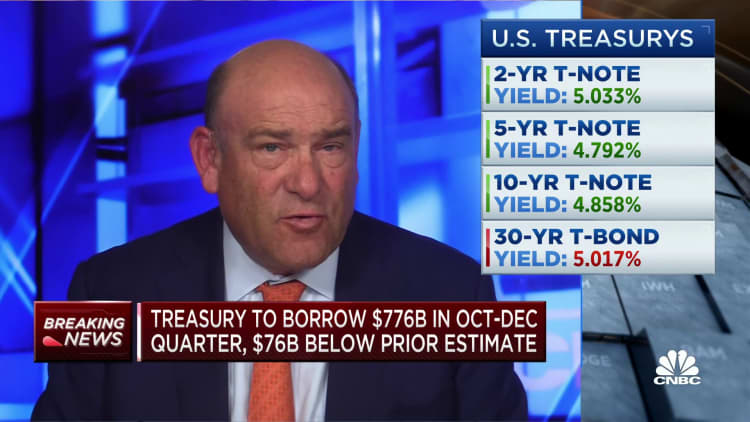The U.S. government’s borrowing needs will decline slightly in the final three months of 2023 from the prior quarter, a potentially important development during a turbulent time for the global bond market.
In a closely watched announcement Monday afternoon, the U.S. Department of the Treasury said it will be looking to borrow $776 billion, which is below the $1.01 trillion in privately held marketable debt the department borrowed in the July-through-September period, the highest ever for that particular quarter.
The borrowing level appeared to be somewhat below Wall Street expectations — strategists at JPMorgan Chase said they expected the announcement to be around $800 billion.
When the Treasury announced in July its heightened borrowing needs, it set off a frenzy in the bond market that saw yields hit their highest levels since 2007, the early days of what would become a global financial crisis.
Stocks lost some of their gains but still remained strongly positive after the announcement. Treasury yields were mostly higher.
Markets have been concerned about the effect of higher yields, and the government’s borrowing need, as well as restrictive Federal Reserve policy, have exacerbated those concerns.
Officials attributed the lower borrowing needs to higher receipts, which were offset somewhat by greater expenses.
The Treasury said it expects to borrow $816 billion during the January-through-March period, which is the government’s fiscal second quarter. That number appeared above Wall Street estimates, as JPMorgan said it was looking for $698 billion. The record for quarterly borrowing happened in the April-through-June stretch in 2020, when borrowing hit nearly $2.8 trillion during the early Covid-19 pandemic days.
The department said it expects to maintain a $750 billion cash balance for both quarters.
Markets will be watching a Wednesday refunding announcement from the Treasury, which will detail the size of auctions, the duration being issued and their timing. Later that day, the Federal Reserve will conclude its two-day policy meeting, with markets overwhelmingly expecting the central bank to hold interest rates steady.
The Monday announcement comes 10 days after the government said the fiscal 2023 budget deficit would be about $1.7 trillion. That was an increase of some $320 billion from the prior year.
An accompanying economic summary indicated that growth has remained strong while inflation has cooled, even though it is well above the Federal Reserve’s target. However, the statement indicated that growth is likely to decelerate sharply, falling to 0.7% in the fourth quarter and just 1% for all of 2024.
Don’t miss these CNBC PRO stories:
Credit: Source link




